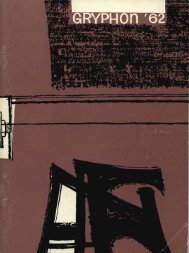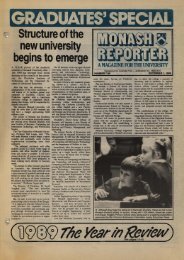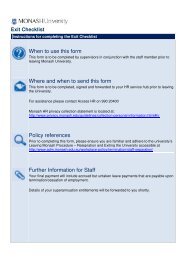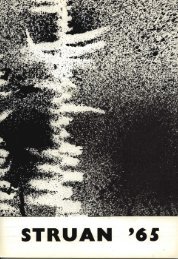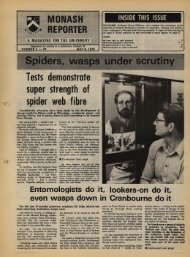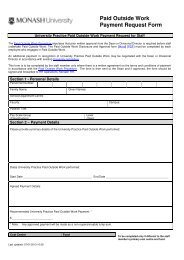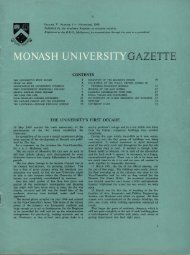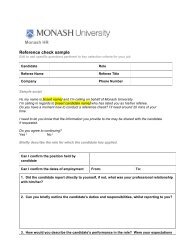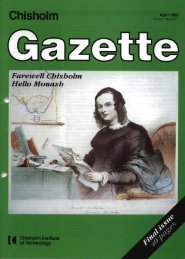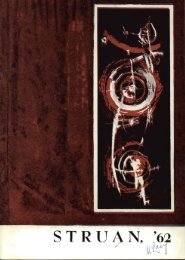Volume 6 Number 1 - Adm.monash.edu.au - Monash University
Volume 6 Number 1 - Adm.monash.edu.au - Monash University
Volume 6 Number 1 - Adm.monash.edu.au - Monash University
You also want an ePaper? Increase the reach of your titles
YUMPU automatically turns print PDFs into web optimized ePapers that Google loves.
MONASH UNIVERSITY GAZETTEMargaret Sanders, Miss D. Hyde, and Dr F. I. R. Martinwe demonstrated that the presence of this material wasdependent on a functional pituitary gland. Research wasthen switched to the pituitary and we were able todemonstrate that the material was derived from pituitarygrowth hormone and was of small molecular weight.Laboratory studies with partially purified insulin antagonistfrom growth hormone, however, at times producedanomalous results. Statistical studies of these indicatedthat the insulin antagonist was contaminated by a similar-sizedmolecule with diametrically opposed action.These were separated in micro quantities and studiesbegan at <strong>Monash</strong> into two aspects of the problem.'The first was obviously into methods of preparationand purification and the second into the mechanism ofaction of these fractions.'Although these studies are still proceeding, sufficientdata had been obtained by the beginning of 1968 toindicate clearly that the insulin antagonist operated byspecifically inhibiting three enzymes involved in glucoseuse and fat synthesis and by virtue of these actions indirectlystimulated the use of fat. The other fraction (codenamed ACG) reversed these four actions by competitiveaction on the three enzymes involved.'Study of the model systems thus derived enabled anhypothesis as to the c<strong>au</strong>se of diabetes mellitus in thepresence of insulin to be made.'In order to test this hypothesis, a group of volunteerpatients, all known to be capable of secreting insulin,were injected with ACG and their blood sugar levelsfollowed. In all cases there was a highly significant fallin blood sugar, thus suggesting that the hypothesis wastenable and bringing up the possibility of a new methodof treatment of a condition affecting over 2 per cent ofany high living standard community.'From this point research has to follow two lines.Firstly we will continue to investigate the systems involvedin these actions, to elucidate completely thestructure of the two polypeptides and to synthesize them.'Secondly, an investigation into the possible role ofACG in the treatment of diabetes mellitus has alreadycommenced in association with the Alfred Hospital'sMetabolic Unit headed by Dr H. P. Taft. It must berealized that at this time we do not even know thecorrect dosage of ACG, the time relations of administrationor indeed whether it has any advantages overorthodox methods of treatment.'Such an investigation is necessarily prolonged andits cost on a scale capable of yielding results in areasonable period of time far beyond the resources ofthe <strong>University</strong> or our hospitals. Thus the scale of theundertaking is beyond our control.'Professor Bornstein concluded by saying he wishedto thank all members of the research group, notablyDr J. Me D. Armstrong, Dr F. M. Ng, Dr H. P. Taft,Dr M. Gould. Professor M. E. Krahl, Mrs L B. Marshalland our graduate scholars, for their contributionsin taking the problem to this point.MONASH STUDENTS SET RECORD IN BLOODDONATION<strong>Monash</strong> <strong>University</strong> students donated 345 pints of bloodduring a four-day visit to the campus by the Red CrossBlood Bank in October 1969. This figure is the highestever reached at the <strong>University</strong>.Miss Mona Lai, sociology student, shown in the potteryclass conducted by the Fine Arts clubEXTRA-CURRICULAR COURSES PROVIDED BYTHE UNION AND STUDENT CLUBSTn 1969 the <strong>University</strong> Union and student clubs andsocieties offered courses of extra-curricular tuition insubjects ranging from handcrafts to languages. Over1,000 students and members of staff participated inthese classes, some of which were organized by theUnion staff, and others by student clubs. In many casesprofessional people from outside the <strong>University</strong> werehired to take classes on the campus.Although most tuition was given on a small classbasis, seventy people received individual tuition in theplaying of musical instruments and singing.Among: the wide range of subjects offered there werecourses in Italian. Esperanto, Hebrew, various forms ofdancing and music, the fine arts and effective speaking.Many of these activities are to be included in theprospectus for a <strong>Monash</strong> Summer School which has beenarranged by the Union for January and February 1970.FOURTH HALL OF RESIDENCE NAMED<strong>Monash</strong>'s fourth hall of residence, the building ofwhich will commence early in 1970, has been named'Roberts Hall' after the Australian artist, Tom Roberts(1869-1931), a prominent member of the Heidelbergschool of painting.The decision that the hall would be so named is inkeeping with the plan to name the halls of residence afterdistinguished Australians.A planned fifth residential hall will bear the name'Richardson Hall', after the novelist Henry HandelRichardson (1870-1940), the <strong>au</strong>thor of The Fortunes ofRichard Mahony.The three existing halls are named Deakin, Farrer andHowitt Halls.10




